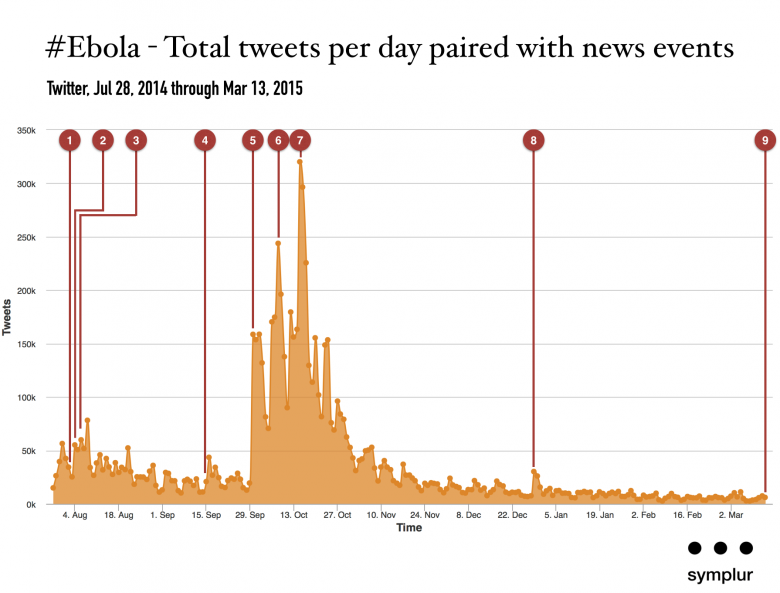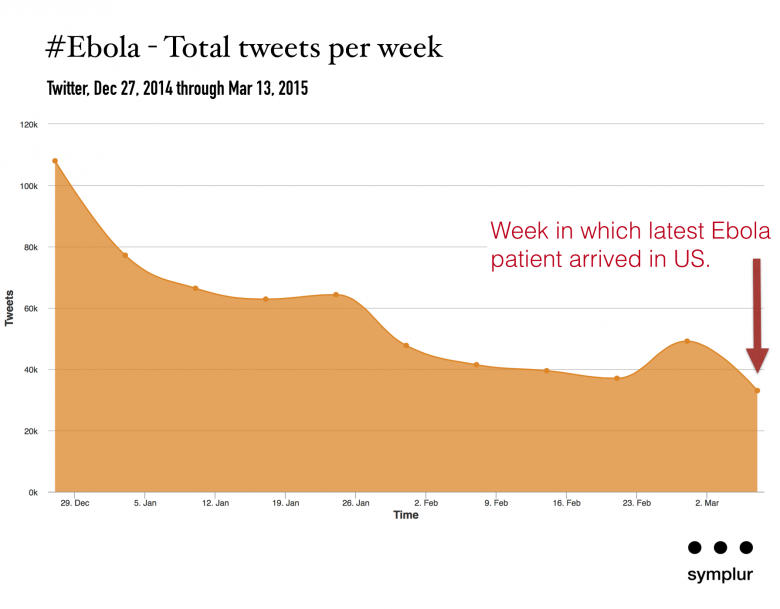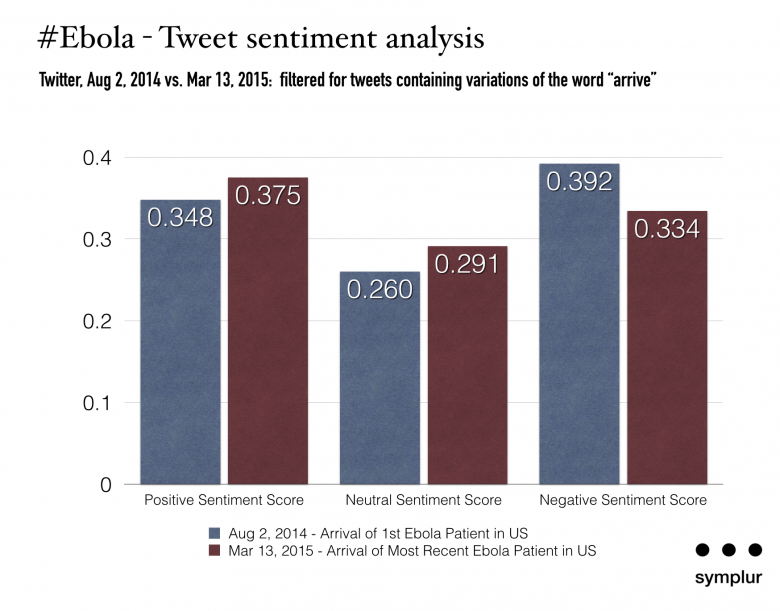The Ebola virus outbreak was the biggest news story of 2014, and while it actually started in late 2013, it continues today. Mainstream media began leading its daily stories with Ebola in late July, 2014, and it was at that time that Symplur began tracking the related conversation on Twitter. Now, with the number of active cases dropping substantially, we can take a step back and view the life cycle of this event and how it has played out on Twitter by delving into the tweet data on the #Ebola hashtag.
Ebola on Twitter … a change in pattern
In the eight plus months since we began capturing and analyzing Ebola on Twitter there have been major news stories that seemed to fuel the online conversation. The data told us that much of that reaction was likely based on fear. And, unfortunately, much of it was also based on ignorance and a sense that it was a distant, non-threatening “side-show”.
The image below displays some of those news events and their impact on the subsequent conversation on Twitter.

- August 2, 2014 – First US Ebola patient arrives at hospital in Atlanta, Georgia.
- August 5, 2014 – Second US Ebola patient arrives at hospital in Atlanta, Georgia.
- August 7, 2014 – First European Ebola patient arrives in Madrid.
- September 15, 2014 – President Obama announces that the US is sending up to 3,000 troops to West Africa to assist in responding to Ebola outbreak.
- September 30, 2014 – Man in Dallas, Texas is first to be diagnosed with Ebola on US soil.
- October 8, 2014 – Man diagnosed with Ebola in Dallas, Texas dies of the disease.
- October 15, 2014 – Second nurse caring for Ebola patient in Dallas, Texas is diagnosed with the disease.
- December 29, 2014 – Woman is first to be diagnosed with Ebola in the UK.
- March 13, 2015 – Healthcare worker who contracted Ebola while volunteering in a Sierra Leone arrives at Maryland hospital.
The above represent only a handful of the many noteworthy events during this outbreak. However, they demonstrate over time how the news stories drove surges in the discussion of Ebola on Twitter.
We can also see how the latest announcement of an Ebola case arriving on US soil has barely caused a blip on the graph. Why is that?
A closer look shows that in spite of this most recent event, activity actually drops off from preceding weeks. This is in stark contrast both in pattern and total number of tweets from when patients arrived in Atlanta as the first two cases of Ebola on US soil last August.

Does this change in pattern on social media reflect a growing indifference to a serious health threat? Have we become used to all the noise? And, if so, is it because the feared global spread never occurred?
Ebola, Twitter, and sentiment analysis
Looking further into this “non-reaction” we compare the sentiment of tweets that occurred on the day in which the first Ebola patient was brought to the US vs. the day the most recent Ebola patient arrived in the US. For both days we first filtered tweets to only address those that included variations of the word “arrive”, thereby allowing us to drill down to the sub-conversation specific to the arrival of the patients in question. In this measurement a score of “1” is extreme and seldom seen. As such, we instead look at variances when comparing the two data sets.

In this case we see an obvious shift in public perception. Most notable, when looking at the negative sentiment score from the first date to the next we see it drop by 14.8%.
This shift in attitude is further demonstrated in the following two tweets. Both of which were among the very (extreme) most negative tweets on the two days studied. The difference in tone is obvious.
August 2, 2014, first ebola case arrives in the U.S. – Negative sentiment score of 0.889
Perfect script for a bad movie."@ewnreporter: A plane carrying a US aid worker infected with the deadly #Ebola virus has arrived in Georgia.
— Wilbar Steenkamp (@Wisteen) August 2, 2014
March 13, 2015, most recent ebola case arrives in the U.S. – Negative sentiment score of 0.667
USA | American healthcare worker with #Ebola virus disease arrives safely at NIH Clinical Center http://t.co/mdcDnjE8Ln #SeriousCondition
— Hal Newman (@BigMedicine) March 14, 2015
The significant point that this data brings home is that our “fear-factor” appears to have dropped off, while at the same time the “indifference-factor” may have increased. One could say this is both good news and bad news. Irrational fears have subsided, but there may also be an all too casual acceptance that again pushes the topic dangerously far out of our thoughts. Meanwhile the disease persists in the very real lives of our global neighbors. Just a stone’s throw away in today’s mobile society.

6 Responses to “The Life Cycle of Ebola on Twitter”
Alex Talbott
Thanks for publishing this. It’s interesting to see the potential normalising of Ebola and better understanding of actual risk (vs perceived risk), via Twitter’s lense.
It’d be good to see a statistical analysis of the sentiment scores to see if they are in fact significant. I’m no statistician but I’d guess a two tailed T-test might work?!
Thomas M. Lee, B.S., NHA
Thanks for the observations, Alex. I agree that it really is interesting to see how, on social media anyway, the public’s reaction to this disease has changed over just a few months. Nice idea about a more thorough statistical analysis of the sentiment scores! We certainly could do that. There’s a huge amount of social media data that we’ve captured on this topic since last July, and I’m sure there’s much we can learn from it and it’s impact. For perspective, to date we’ve recorded over 314 Billion impressions on the “ebola” keyword.
Enrique Castro Sanchez
Hi Thomas,
Great post! I wonder how comparable these results are to Househ M. Communicating Ebola through social media and electronic news media outlets: A cross-sectional study. Health Informatics J. 2015 Feb 5. pii: 1460458214568037 as well as Rodriguez-Morales AJ, Castañeda-Hernández DM, McGregor A. What makes people talk about Ebola on social media? A retrospective analysis of Twitter use. Travel Med Infect Dis. 2015 Jan-Feb;13(1):100-1. doi: 10.1016/j.tmaid.2014.11.004
Kind regards,
Enrique
Thomas M. Lee, B.S., NHA
Thank you for your comment, Enrique. While I’m not immediately familiar with the studies you’ve referred to, I’m a believer that there is much more to be learned from the massive amount of conversation that occurred about ebola in the online space … all of which has left a digital record just begging to be studied.
To date we’ve collected over 60 million ebola related tweets by more than 12 million individuals, which have left more than 318 billion impressions. And ebola is just one example. The proliferation of health related discussions online is growing, and there is representation from all stakeholders.
The Social Nurse | Get Your #Hashtag On!
[…] The blog is full of practical information and analysis of trends in healthcare social media. Check out this post and channel your inner epidemiologist: The Life Cycle of Ebola on Twitter. […]
Mike
Hi Thomas,
Concise and intuitive article and data presented. What tool did you use to pull this twitter data?
Thanks!
Mike